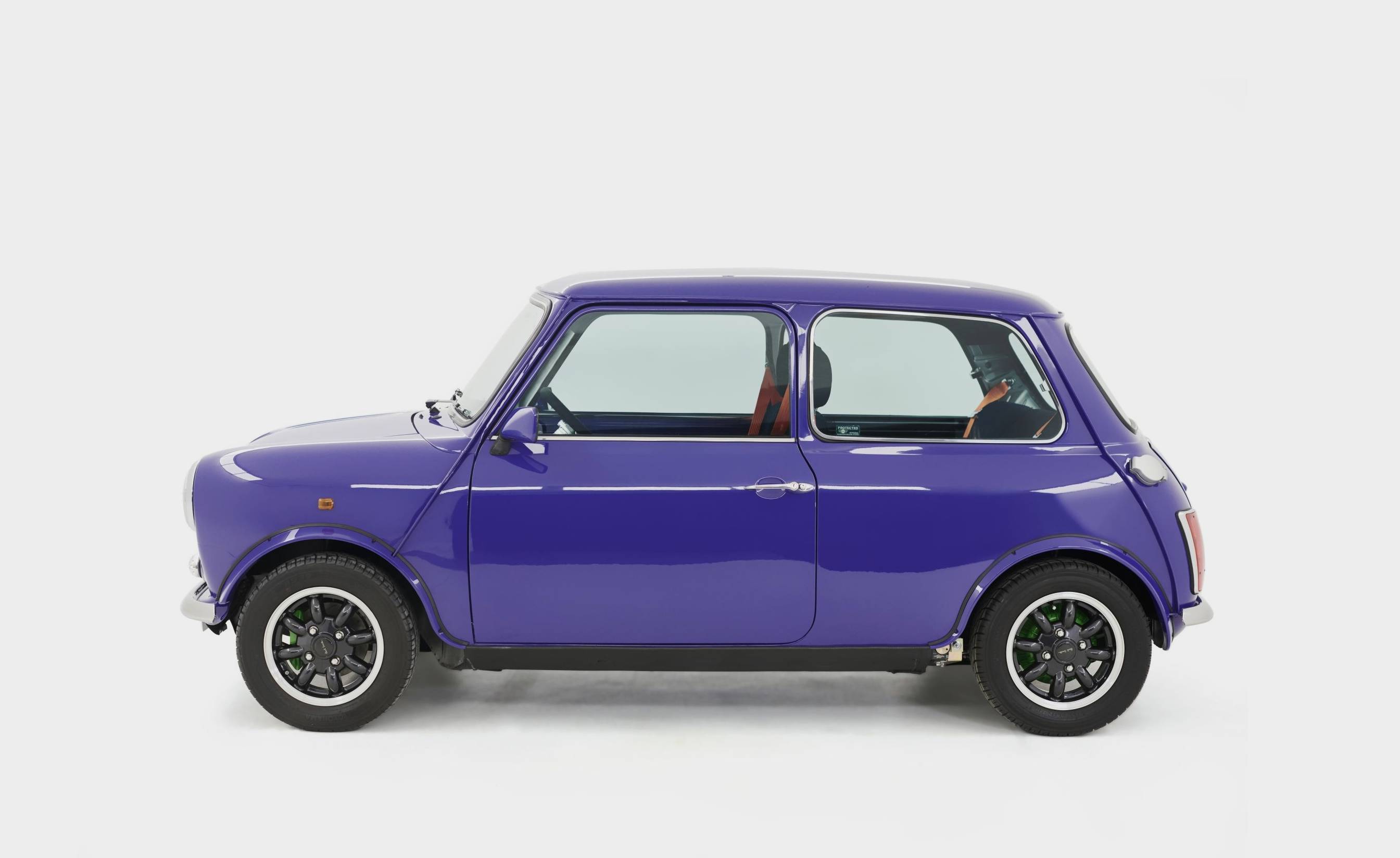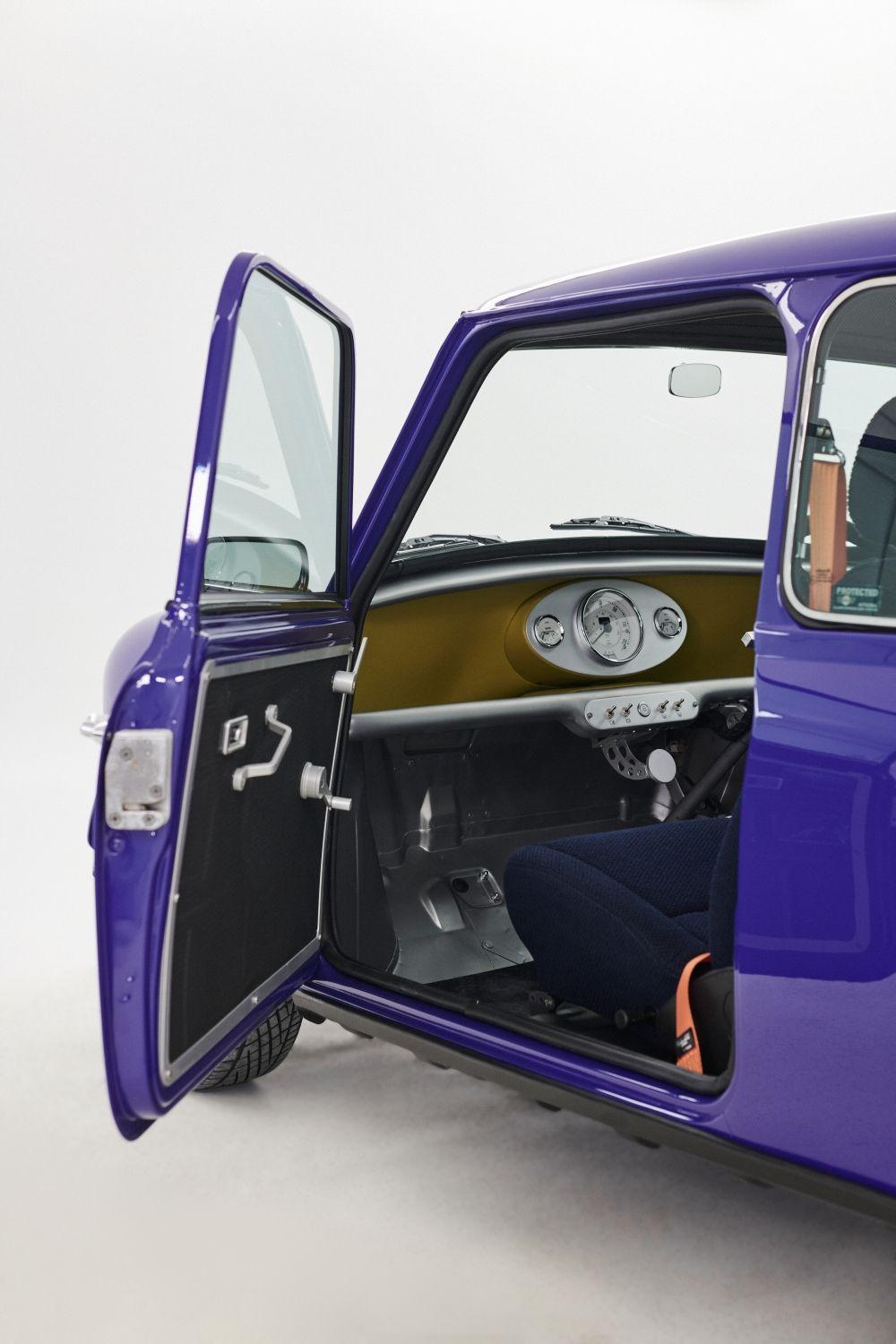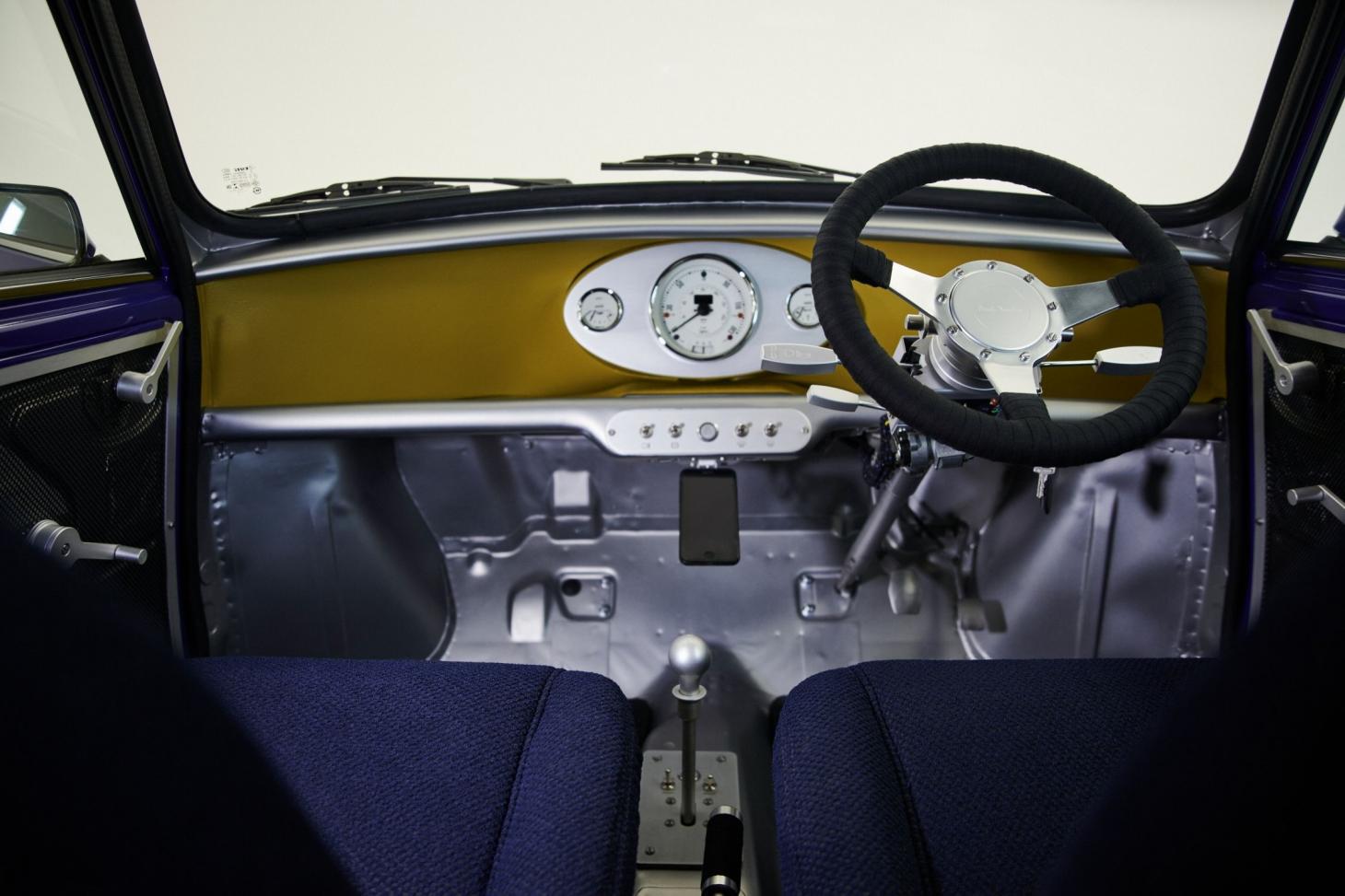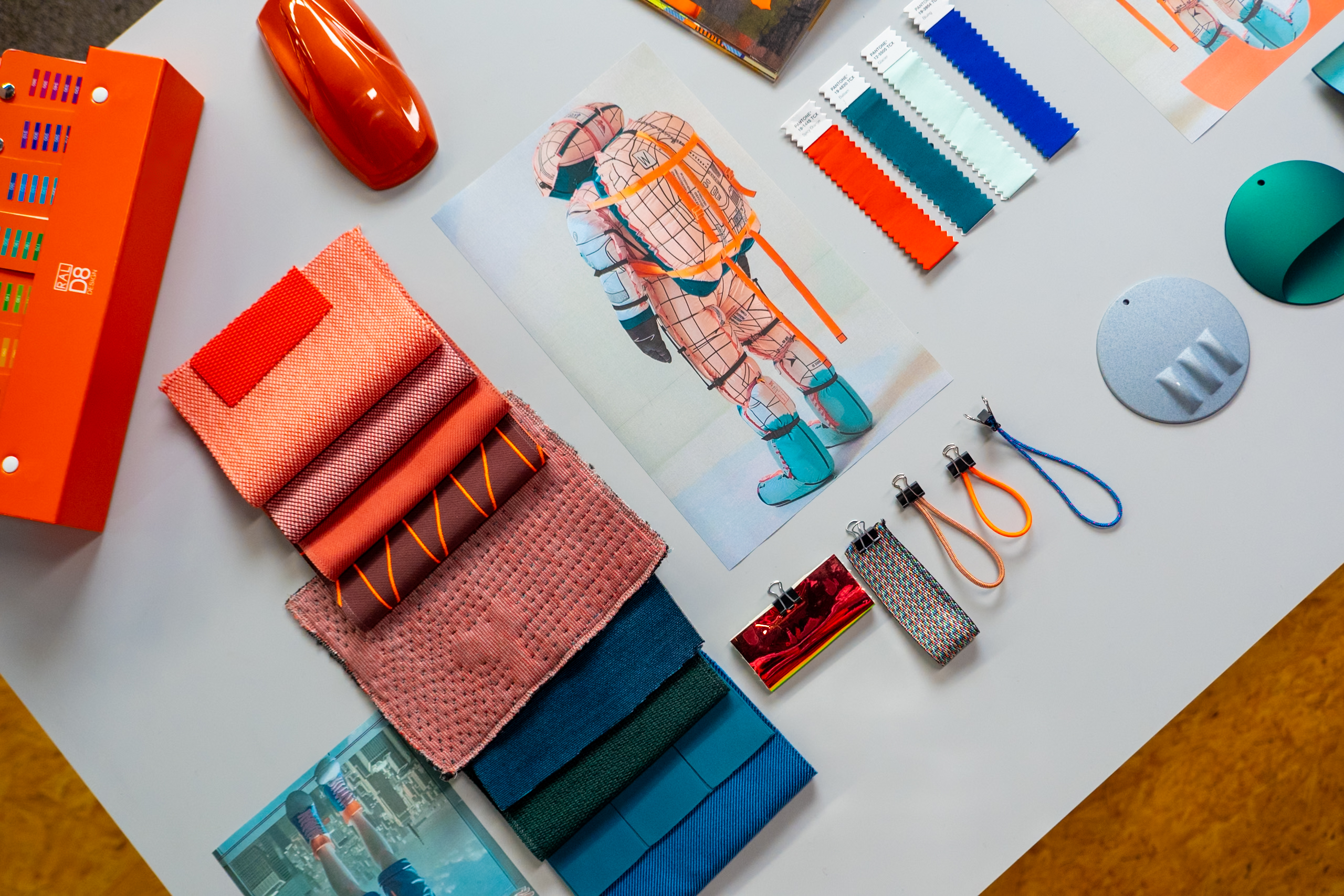Mini Recharged: Sir Paul Smith’s contemporary cut for a classic
Reimagining his 1998 take on the small car with a big following, Sir Paul Smith tailors the stripped-back 2022 Mini Recharged

Sir Paul Smith’s association with Mini goes way back. His most recent collaboration – a conceptual version of the new electric Mini, the Mini Strip – was revealed in 2021 and immediately hailed for its combination of minimal trim and enduring materials. Back in 1998, the Mini Paul Smith Edition, a limited edition of 1,800 vehicles, added pinstripe chic to the original Sir Alec Issigonis-designed Mini.

Sir Paul Smith and the Mini Recharged project
Now the designer has collaborated once more with Oliver Heilmer, head of Mini Design, to create the Mini Recharged, an upcycled original 1998 Mini that’s been given the electrification treatment.
Revealed at Salone Del Mobile 2022, the Mini Recharged hasn’t just been rewired from scratch; it also incorporates colours, materials, and trim that reflect a truly sustainable approach. Smith describes the car as a combination of ‘quality, sustainability and functionality,’ and it’s easy to be seduced by this stripped-back version of one of the most enduring designs of all time.

Stabs of bright colour are a perennial Smith signature, and the Mini Recharge doesn’t disappoint, with orange seatbelts, a yellow dashboard shelf, and a lime-green battery box in the boot. The Recharged’s bodywork is finished in a bright blue colour originally inspired by one of the designer’s favourite shirts.

There are still plenty of classic Minis on the roads and the cars retain a strong cult following. Launched in 1959 as the ultimate compact car for a family of modest means at a time of the first oil shock of the modern era after the Suez Crisis, it was economical and cheap to run (if not to actually build).
Engineer Issigonis used a pioneering engine layout to maximise space; 80 per cent of the car’s volume was devoted to passengers and luggage. At 3.05m long, a classic Mini is barely bigger than a contemporary Smart car, yet could seat five.

Swapping out the original engine for electric motors and a battery pack was a substantial operation.
Wallpaper* Newsletter
Receive our daily digest of inspiration, escapism and design stories from around the world direct to your inbox.
New Mini partner Recharged Heritage Limited, a small company based in Lancashire, was responsible for the engineering, installing a 72-kilowatt electric motor to turn the car into a zero-emissions machine.

Changes are subtle but striking. ‘When you move into your old aunt's flat, out of respect you don't change everything, but you do some modernising,’ says Smith, and his interior changes reflect this ethos.
For a start, there’s a distinct absence of interior trim – just as with the Mini Strip – helping reduce weight and creating a uniquely utilitarian finish. The bare metal footwells are covered with recycled rubber floor mats, while the instrument panel is just as stark as Mini’s original, with the round centre-mounted speedo complemented by a smartphone mounting. The gear selector, switch gear, column stalks and windscreen winders are all machined aluminium; and the steering wheel itself is removable, just like on a racing car.

‘Ideas are never the problem, you can find them everywhere,’ says Smith. ‘The challenge is to implement them. Here it worked. A dream has come true… We have made a 1990s car totally relevant for today.’
While last year’s Mini Strip was a step too far for mass production, the bespoke nature of the Recharged project and the ongoing partnership with Recharged Heritage Limited hints at this being more than an elegant one-off.

Sir Paul Smith and Oliver Heilmer, head of Mini Design



Jonathan Bell has written for Wallpaper* magazine since 1999, covering everything from architecture and transport design to books, tech and graphic design. He is now the magazine’s Transport and Technology Editor. Jonathan has written and edited 15 books, including Concept Car Design, 21st Century House, and The New Modern House. He is also the host of Wallpaper’s first podcast.
-
 Ligne Roset teams up with Origine to create an ultra-limited-edition bike
Ligne Roset teams up with Origine to create an ultra-limited-edition bikeThe Ligne Roset x Origine bike marks the first venture from this collaboration between two major French manufacturers, each a leader in its field
By Jonathan Bell
-
 The Subaru Forester is the definition of unpretentious automotive design
The Subaru Forester is the definition of unpretentious automotive designIt’s not exactly king of the crossovers, but the Subaru Forester e-Boxer is reliable, practical and great for keeping a low profile
By Jonathan Bell
-
 Sotheby’s is auctioning a rare Frank Lloyd Wright lamp – and it could fetch $5 million
Sotheby’s is auctioning a rare Frank Lloyd Wright lamp – and it could fetch $5 millionThe architect's ‘Double-Pedestal’ lamp, which was designed for the Dana House in 1903, is hitting the auction block 13 May at Sotheby's.
By Anna Solomon
-
 More colour and more design. More modernity. More Mini
More colour and more design. More modernity. More MiniThe iconic manufacturer has upped its game on tone, texture and interiors
By Jonathan Bell
-
 Coming soon: a curated collection of all the new EVs and hybrids that matter
Coming soon: a curated collection of all the new EVs and hybrids that matterWe've rounded up new and updated offerings from Audi, Porsche, Ineos, Mini and more to keep tabs on the shifting sands of the mainstream car market
By Jonathan Bell
-
 24 transportation design innovations for 2024
24 transportation design innovations for 2024From electric cars to new airports and sports boats, here’s a non-exhaustive list of 24 of the most interesting transportation design innovations to expect in the coming year
By Jonathan Bell
-
 Year in review: the top 10 cars of 2023, as selected by Wallpaper’s Jonathan Bell
Year in review: the top 10 cars of 2023, as selected by Wallpaper’s Jonathan BellWhat were the best four-wheeled offerings of 2023? Transport editor Jonathan Bell takes us through the year’s most intriguing automobiles
By Jonathan Bell
-
 David Brown Automotive transforms original Mini into a high-end, high-spec EV
David Brown Automotive transforms original Mini into a high-end, high-spec EVThe DBA Mini eMastered: luxury motoring is rarely so altruistic and joyful
By Jonathan Bell
-
 Mini E-Bike 1, with Angell Mobility, is the carmaker’s first electric two-wheeler
Mini E-Bike 1, with Angell Mobility, is the carmaker’s first electric two-wheelerThe Mini E-Bike 1 opens up a new chapter for Mini, a collaboration that adds another mobility option to its freshly electrified range
By Jonathan Bell
-
 Two new electric Minis bring back the playful spirit of the original
Two new electric Minis bring back the playful spirit of the originalThe new Mini Countryman and Mini Cooper give the modern icon a cleaner, minimal appearance and bolster the interior tech and trim
By Jonathan Bell
-
 ‘The Atlas of Car Design’ chronicles 130 years of automotive art
‘The Atlas of Car Design’ chronicles 130 years of automotive artPhaidon’s epic monograph ‘The Atlas of Car Design: The World’s Most Iconic Cars’ assembles a multistorey’s worth of precious metal from around the world
By Jonathan Bell